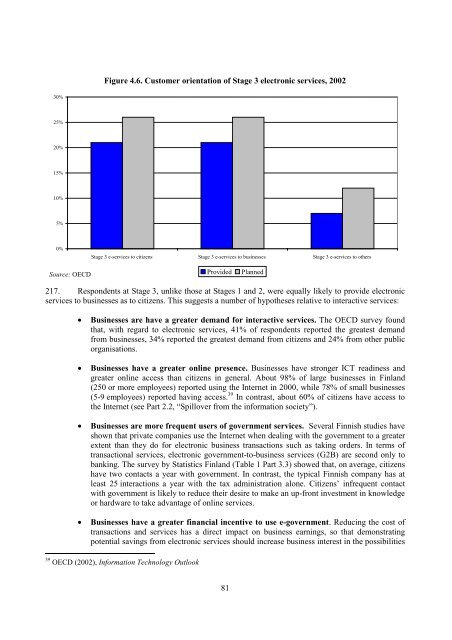e-GOVERNMENT IN FINLAND - ePractice.eu
e-GOVERNMENT IN FINLAND - ePractice.eu
e-GOVERNMENT IN FINLAND - ePractice.eu
You also want an ePaper? Increase the reach of your titles
YUMPU automatically turns print PDFs into web optimized ePapers that Google loves.
30%<br />
25%<br />
20%<br />
15%<br />
10%<br />
5%<br />
0%<br />
Source: OECD<br />
Figure 4.6. Customer orientation of Stage 3 electronic services, 2002<br />
Stage 3 e-services to citizens Stage 3 e-services to businesses Stage 3 e-services to others<br />
217. Respondents at Stage 3, unlike those at Stages 1 and 2, were equally likely to provide electronic<br />
services to businesses as to citizens. This suggests a number of hypotheses relative to interactive services:<br />
x Businesses are have a greater demand for interactive services. The OECD survey found<br />
that, with regard to electronic services, 41% of respondents reported the greatest demand<br />
from businesses, 34% reported the greatest demand from citizens and 24% from other public<br />
organisations.<br />
x Businesses have a greater online presence. Businesses have stronger ICT readiness and<br />
greater online access than citizens in general. About 98% of large businesses in Finland<br />
(250 or more employees) reported using the Internet in 2000, while 78% of small businesses<br />
(5-9 employees) reported having access. 39 In contrast, about 60% of citizens have access to<br />
the Internet (see Part 2.2, “Spillover from the information society”).<br />
x Businesses are more frequent users of government services. Several Finnish studies have<br />
shown that private companies use the Internet when dealing with the government to a greater<br />
extent than they do for electronic business transactions such as taking orders. In terms of<br />
transactional services, electronic government-to-business services (G2B) are second only to<br />
banking. The survey by Statistics Finland (Table 1 Part 3.3) showed that, on average, citizens<br />
have two contacts a year with government. In contrast, the typical Finnish company has at<br />
least 25 interactions a year with the tax administration alone. Citizens’ infrequent contact<br />
with government is likely to reduce their desire to make an up-front investment in knowledge<br />
or hardware to take advantage of online services.<br />
x Businesses have a greater financial incentive to use e-government. Reducing the cost of<br />
transactions and services has a direct impact on business earnings, so that demonstrating<br />
potential savings from electronic services should increase business interest in the possibilities<br />
39 OECD (2002), Information Technology Outlook<br />
Provided Planned<br />
81
















